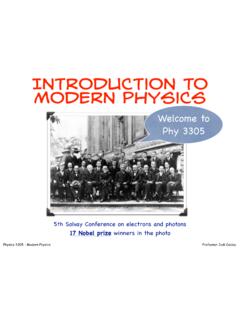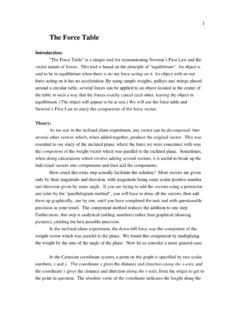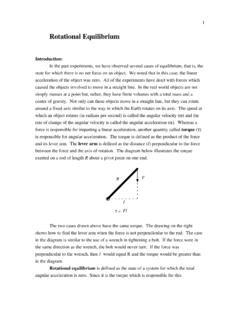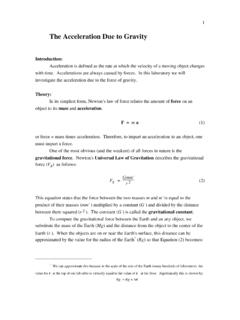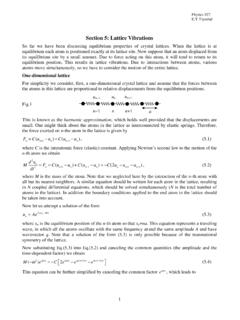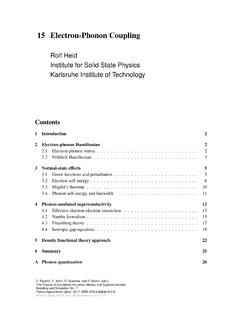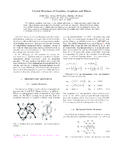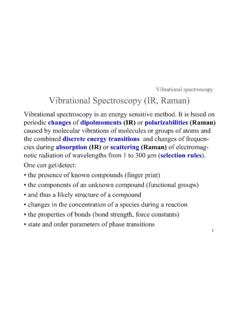Transcription of EP 364 SOLID STATE PHYSICS
1 EP 364 SOLID STATE EP 364 SOLID STATE EP 364 SOLID STATE EP 364 SOLID STATE PHYSICSPHYSICSPHYSICSPHYSICSC ourse CoordinatorProf. Dr. Be ire G n lINTRODUCTIONINTRODUCTION AIM OF SOLID STATE PHYSICS WHAT IS SOLID STATE PHYSICS AND WHY DO IT?EP364 SOLID STATE PHYSICS INTRODUCTIONAND WHY DO IT? CONTENT REFERENCESAim of SOLID STATE PHYSICS SOLID STATE PHYSICS (SSP) explains the properties ofsolid materials as found on earth. ThepropertiesareexpectedtofollowfromEP36 4 SOLID STATE PHYSICS INTRODUCTION ThepropertiesareexpectedtofollowfromSchr dinger s eqn. for a collection of atomic nucleiand electrons interacting with electrostatic forces. The fundamental laws governing the behaviour ofsolids are known and well Solids We will deal with crystalline solids, that is solidswith anatomic structure based on a regularrepeated SOLID STATE PHYSICS INTRODUCTION Many important solids are crystalline.
2 More progress has been made in understanding thebehaviour of crystalline solids than that of non6crystalline materialssince the calculation are easierin crystalline is SOLID STATE PHYSICS ? SOLID STATE PHYSICS , also known ascondensed matterphysics, is the study of the behaviour of atoms SOLID STATE PHYSICS INTRODUCTION theyareplacedincloseproximitytooneanothe r. In fact, condensed matter PHYSICS is a much bettername, since many of the concepts relevant to solidsare also applied to liquids, for is the point? Understanding the electrical properties of solidsisright at the heart of modern societyand SOLID STATE PHYSICS INTRODUCTION The entirecomputer and electronics industryrelieson tuning of a special class of material, thesemiconductor, which lies right at the metal6insulator boundary.
3 SOLID STATE PHYSICS provide abackground to understand what goes on STATE PHYSICS (SSP) is the applied PHYSICS New technology for the future will inevitably involvedeveloping and understanding new classes ofmaterials. By the end of this course we will see whyEP364 SOLID STATE PHYSICS INTRODUCTION this is a non6trivial task. So,SSP is the applied physicsassociated withtechnology rather than interesting resistivity of three states of SOLID matter How can this be? After all, they each contain a system ofatoms and especially electrons of similar density. And theplot thickens:graphite is a metal,diamond is an insulatorandbuckminster6fullerene is a are all just carbon!EP364 SOLID STATE PHYSICS INTRODUCTION Among our aims 6understand whyone is ametaland one an insulator, and then the physical origin of themarked features.
4 Also think about thermal properties etc. Chapter Structure Chapter Crystallography Chapter ForcesEP364 SOLID STATE PHYSICS INTRODUCTION Chapter Forces Chapter Dynamics Chapter Electron TheoryCHAPTER STRUCTURE Elementary Crystallography SOLID materials (crystalline, polycrystalline, amorphous) Crystallography Crystal LatticeEP364 SOLID STATE PHYSICS INTRODUCTION Crystal lattice Crystal Structure Types of Lattices Unit Cell Directions6 Planes6 Miller Indices in Cubic Unit Cell Typical Crystal Structures (3D 14 Bravais Lattices and the Seven Crystal System) Elements of SymmetryCHAPTER 2. X-RAY CRYSTALLOGRAPHY X6ray Diffraction Bragg equation X6ray diffraction methodsEP364 SOLID STATE PHYSICS INTRODUCTION X6ray diffraction methods Laue Method Rotating Crystal Method Powder Method Neutron & electron diffraction CHAPTER 3.
5 INTERATOMIC FORCES Energies of Interactions Between Atoms Ionic bonding NaCl Covalent bondingEP364 SOLID STATE PHYSICS INTRODUCTION Covalent bonding Comparision of ionic and covalent bonding Metallic bonding Van der waals bonding Hydrogen bondingCHAPTER 4. CRYSTAL DYNAMICS Sound wave lattice vibrations of 1D cystal Chain of identical atoms Chain of two types of atoms Phonons EP364 SOLID STATE PHYSICS INTRODUCTION Phonons Heat Capacity Density of States Thermal Conduction Energy of harmonic oscillator Thermal energy & lattice Vibrations Heat Capacity of lattice vibrationsCHAPTER 5. FREE ELECTRON THEORY Free electron model Heat capacity of free electron gas Fermi function, Fermi energyEP364 SOLID STATE PHYSICS INTRODUCTION Fermi function, Fermi energy Fermi dirac distribution function Transport properties of conduction electronsREFERENCES Core book: SOLID STATE PHYSICS , and ,Second edition (Wiley) Other books at a similar level:Solidstatephysics,Kittel(Wiley)EP3 64 SOLID STATE PHYSICS INTRODUCTIONS olidstatephysics,Kittel(Wiley) SOLID STATE PHYSICS , Blakemore (Cambridge)Fundamentals of SOLID STATE PHYSICS , Christman(Wiley) More advanced.
6 SOLID STATE PHYSICS , Ashcroft andMerminCHAPTER 1 CRYSTAL STRUCTUREE lementary CrystallographyTypical Crystal StructuresElements Of SymmetryObjectivesBy the end of this section you should: be able to identify a unit cellin a symmetrical Crystal Structure18 be able to identify a unit cellin a symmetrical pattern know that there are 7 possible unit cell shapes be able to define cubic, tetragonal, orthorhombic and hexagonal unit cell shapesMattermattermatterCrystal Structure19 GASESLIQUIDS LIQUIDS LIQUIDS LIQUIDS andandandand LIQUID LIQUID LIQUID LIQUID CRYSTALSCRYSTALSCRYSTALSCRYSTALSSOLIDSSO LIDSSOLIDSSOLIDSG ases Gases have atoms or molecules that do not bond to one another in a range of pressure, temperature and volume. These molecules haven t any particular order Crystal Structure20 These molecules haven t any particular order and move freely within a and Liquid Crystals Similar to gases, liquids haven t any atomic/molecularorder and they assume the shape of the containers.
7 Applying low levels of thermal energy can crystals have mobilemolecules, but a type of longrange order can exist; themolecules have a permanentdipole. Applying an electric fieldrotates the dipole and establishesorder within the collection Solids consist of atoms or moleculesexecuting thermal motionabout anequilibrium positionfixed at a pointin space. Solidscantaketheformofcrystalline,Crysta l Structure22 Solidscantaketheformofcrystalline,polycr stalline, or amorphous materials. Solids (at a given temperature, pressure, andvolume)have stronger bondsbetweenmolecules and atoms than liquids. Solidsrequire more energytobreak MATERIALSCRYSTALLINECRYSTALLINECRYSTALLI NECRYSTALLINEPOLYCRYSTALLINEPOLYCRYSTALL INEPOLYCRYSTALLINEPOLYCRYSTALLINEAMORPHO USAMORPHOUSAMORPHOUSAMORPHOUS(Non(Non(No n(Non----crystalline)crystalline)crystal line)crystalline)ELEMENTARY CRYSTALLOGRAPHYELEMENTARY CRYSTALLOGRAPHYC rystal Structure23 Single CrystalTypes of Solids Single crsytal, polycrystalline, and amorphous, are the three general types of solids.
8 Each type is characterized by the size of ordered region within the Structure24region within the material. An ordered region is a spatial volume in which atoms or molecules have a regular geometric arrangement or SOLID Crystalline Solidisthe SOLID form of a substance inwhich theatoms or moleculesare arranged ina definite, repeating pattern in three dimension. Single crystals, ideallyhave a high degree of order, orregulargeometricperiodicity,throughout theentireCrystal Structure25regulargeometricperiodicity,t hroughouttheentirevolume of the SOLID Single crystalhas an atomic structure that repeatsperiodically across its whole volume. Even at infinite lengthscales, each atom is related to every other equivalentatom in the structure by translational symmetryCrystal Structure26 Single CrystalSingle PyriteCrystalAmorphousSolidPolycrystalli ne SOLID Polycrystalis a material made up of an aggregate ofmany small single crystals(also called crystallites or grains).
9 Polycrystalline materialhave a high degree of order over many atomic or moleculardimensions. Theseordered regions,or single crytal regions,vary in size and orientation Structure27 PolycrystallinePyrite form(Grain)oneanother. These regions are called asgrains ( domain)and are separated from one anotherbygrain ordercan vary fromone domain to the next. The grains are usually100 nm - 100 microns in diameter. Polycrystals with grainsthat are <10 nm in diameter are callednanocrystallineAmorphous SOLID Amorphous (Non6crystalline) Solidis composed of randomlyorientated atoms , ions, or molecules that do not form definedpatterns or lattice structures. Amorphous materials have order only within a few atomic ormolecular dimensions. Amorphousmaterialsdonothaveanylong6range order,buttheyCrystal Structure28 Amorphousmaterialsdonothaveanylong6range order,buttheyhave varying degrees of short6range order.
10 Examples to amorphous materials include amorphous silicon,plastics, and glasses. Amorphous silicon can be used in solar cells and thin film From Perfect Crystal Strictly speaking, one cannot prepare a perfect crystal. Forexample, even the surface of a crystal is a kind ofimperfection because the periodicity is interrupted there. Anotherexampleconcernsthethermalvibratio nsoftheatomsCrystal Structure29 Anotherexampleconcernsthethermalvibratio nsoftheatomsaround their equilibrium positions for any temperature T>0 K. As a third example, actualcrystal always contains someforeign atoms, , impurities spoils theperfect crystal is crystallography?The branch of science that deals with the geometric descriptionof crystals and their internal arrangement.

